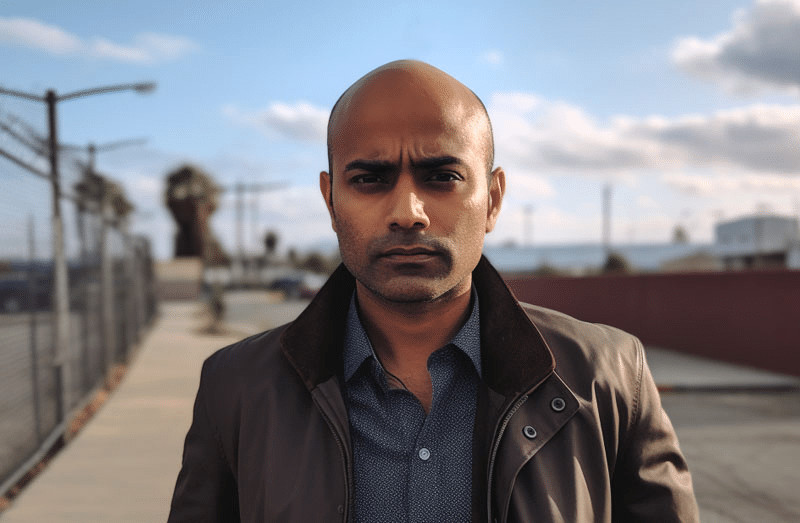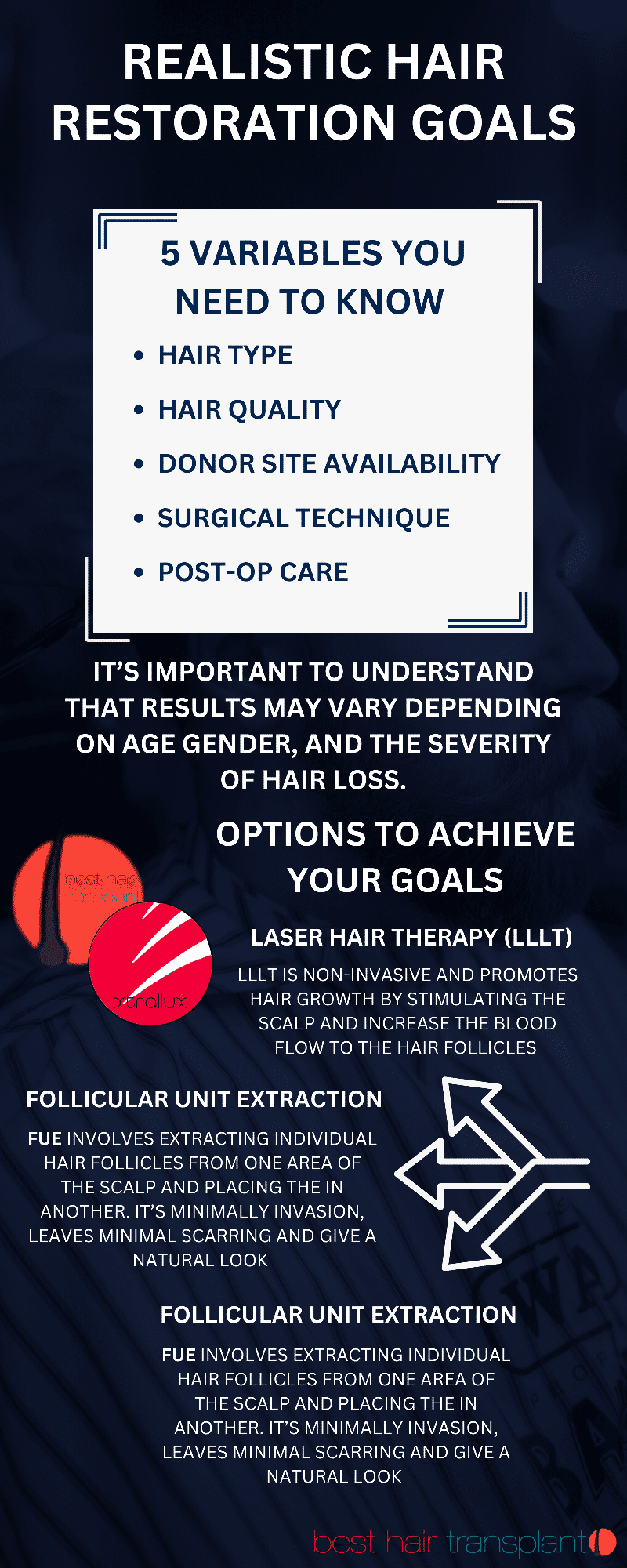When it comes to hair restoration, determining your hair restoration goals is a crucial step in the journey to regaining your lost hair. Hair loss can be a sensitive subject for many individuals, and it’s important to approach the process with a clear understanding of what you hope to achieve.
By setting realistic expectations and being open and honest with your hair restoration doctor, you can ensure that you are taking the necessary steps towards achieving the results you desire. In this blog post, we will discuss the importance of determining your hair restoration goals and provide insights into some options that can help you reach those goals.
What Are My Hair Restoration Goals?

Your hair restoration surgery goals may vary depending on your gender, age, and the severity of your hair loss. Some common goals include regrowing lost hair, restoring a fuller head of hair, improving overall hair health, and boosting self-confidence. It’s important to have realistic expectations when setting your goals as there is no one-size-fits-all solution for hair loss.
You should also consider any lifestyle changes you are willing to make in order to achieve your desired results, such as incorporating a healthier diet or avoiding stressors that can contribute to hair loss.
Am I Ready for a Hair Transplant?

If you are considering a hair transplant, assess whether or not you are truly prepared for the procedure. This involves evaluating your budget, as well as your willingness to commit to post-transplant care and lifestyle changes. It’s also important to discuss any concerns or reservations with your hair restoration doctor during your consultation.
It’s crucial to have realistic expectations about the results of a hair transplant. While it can deliver significant improvements, it may not completely reverse all signs of hair loss. By taking these factors into consideration and being fully committed to the process, you can determine if a hair transplant is the right option for you.
Are My Hair Restoration Goals Realistic?
It’s important to have realistic expectations when it comes to your hair restoration goals. This means understanding that the results may vary depending on factors such as age, gender, and the severity of hair loss. It’s also essential to consider any lifestyle changes or maintenance required post-transplant in order to maintain the results you desire.
Consulting with a hair restoration professional can help you determine if your goals are realistic based on your individual circumstances. They can provide insights into possible outcomes and offer alternative options if necessary. Ultimately, being open and honest with yourself about your goals can help set realistic expectations for the hair restoration process.
Is the Hair Transplant Recovery Process Painful?

The hair transplant recovery process can vary for each individual, but it is generally not considered to be painful. Most patients report minimal discomfort and any pain can easily be managed with over-the-counter pain medication prescribed by your doctor.
During the first few days after a hair transplant, you may experience some swelling or slight soreness around the transplanted area. This is completely normal and should subside within a a few hours or days. It’s important to follow your doctor’s post-operative care instructions to ensure a smooth and comfortable recovery process.
Before Your Transplant: How to Prepare
Before undergoing a hair transplant, it’s important to properly prepare yourself physically and mentally. This includes discussing any medications you are currently taking with your doctor, as certain medications can affect the success of the hair transplantation surgery and hair transplant surgery or interfere with recovery.
It’s also recommended to avoid smoking and drinking alcohol leading up to the procedure, as these habits can also impact healing and results.
Mentally preparing for a hair transplant involves understanding the process and setting realistic expectations for the outcome. It’s important to remember that while a hair transplant can greatly improve the appearance of hair loss, it may not completely restore a full head of hair.
By approaching the procedure with a positive mindset and trusting in your doctor’s expertise, you can better prepare yourself for the journey ahead.
Options to Achieve Your Hair Restoration Goals

Laser Hair Therapy (LLLT)
Laser Hair Therapy (LLLT) is a non-invasive procedure for promoting hair growth and preventing hair loss. It involves the use of low-level laser light to stimulate cell activity in the scalp, thereby increasing blood flow and nutrient delivery to the hair follicles.
One of the major benefits of LLLT is that it can be used as a standalone treatment or in combination with other hair restoration methods. For those who are not ready for surgical procedures or are unable to undergo them due to medical reasons, LLLT can be a viable option. It’s suitable for both men and women experiencing different types of hair loss, including genetic pattern baldness.
The technology behind LLLT has been around for decades, but recent advancements have made it more effective and accessible to the general public. The treatment involves the use of a specialized laser device that emits red light at a specific wavelength. This light penetrates the scalp, stimulating hair follicles and promoting cell growth.
LLLT is a painless and relatively quick procedure, usually taking only 15-30 minutes per session. The recommended frequency for optimal results is two to three times per week for several weeks or months. Many patients report seeing noticeable improvements in hair replacement surgery thickness, density, and overall quality after just a few sessions.
Follicular Unit Extraction (FUE)
Follicular Unit Extraction (FUE) hair transplantation is a surgical hair restoration procedure that involves the extraction of individual hair follicles from the donor area and their transplantation into the already thinning hair, or balding areas of the scalp. This method has gained popularity in recent years due to its minimally invasive nature and natural-looking results.
During an FUE procedure, specialized equipment is used to extract hair plugs one by one from the back or sides of the head, where hair growth is usually thicker and denser. These follicles are then carefully transplanted into tiny incisions made in the recipient area, creating a fuller and more natural-looking hairline.
Major Advantages of FUE Hair Transplantation
One of the major advantages of FUE hair transplant surgery over traditional strip harvesting methods is that it does not leave a visible linear scar. Instead of hairs, the tiny punch marks from the extraction process are barely noticeable and easily concealed by surrounding hair. This makes FUE a popular choice for those who prefer to wear their hair short.
FUE is also a suitable option for patients with limited donor hair as it allows for more precise and targeted extraction of individual follicles. It is also a less invasive procedure compared to strip harvesting, resulting in faster recovery times and minimal discomfort.
However, it should be noted that FUE may not be suitable for every type of hair loss or every patient. The success of the procedure depends on factors such as the quality and quantity of donor hair, age, overall good health, and expectations.
Follicular Unit Transplant (FUT)
Follicular Unit Transplant (FUT) hair transplantation, also known as the strip harvesting method, is a surgical hair restoration procedure that involves removing a strip of scalp from the donor area and dissecting it into individual follicular units for transplantation. This method has been around for several decades and is still considered to be one of the most effective ways to achieve natural-looking results.
During an FUT procedure, a strip of skin with healthy hair follicles is removed from the back or sides of the head. The incision is closed using sutures or staples, leaving a linear scar which can be easily concealed by surrounding hair. The extracted strip is then dissected into tiny pieces and individual follicular units under magnification before being transplanted into the recipient area.
Major Advantages of FUT Hair Transplant Surgery
One of the major advantages of FUT is that it allows for a larger number of grafts to be transplanted in a single session compared to other methods. This makes it a more efficient option for patients who require a significant amount of hair restoration. It also has a higher success rate and can provide long-lasting results.
Similar to FUE, the success of an FUT procedure depends on factors such as the quality and quantity of donor hair, age, overall health, and expectations. It is also important to note that FUT may leave a visible linear scar which may not be suitable for those who prefer short hairstyles.
What to Expect After Your Hair Transplant: Month-by-Month Growth & Recovery
After undergoing a hair transplant, it’s important to have realistic expectations for the growth and recovery process. While results may vary, here is what you can generally expect to grow hair, month-by-month:
Month 1: The transplanted hairs will shed as your scalp heals.
Months, weeks 2-3: Each new hair follicle will begin to grow and become visible.
Months 4-6: Hair growth will continue and become more noticeable.
Months 7-12: You should see significant improvement in existing hair, with fuller and thicker hair.
While new hair growth may be visible after a few months, it can take up to a year for final results to be fully realized. It’s also important to continue following your doctor’s instructions for post-operative care to ensure proper healing and optimal results.
5 Important Things You Should Know About Hair Transplants
If you’re considering a hair transplant, here are five important things to keep in mind. Remember, your results will depend on your own natural appearance, hair growth patterns, and the skill of your doctor.
Hair transplants do not prevent further hair loss, so additional treatments may be needed in the future. You may experience temporary shedding or shock loss after hair restoration surgery, but this is normal and new hair growth will occur.
The cost to perform hair transplants can vary depending on factors such as surgical hair restoration techniques used, location, and number of grafts required. It’s important to choose a reputable and experienced doctor for your procedure to ensure safe and successful results.
In addition, it’s common for individuals to have questions about combining hair transplants with other treatments, such as taking creatine and amino acids.
Variables of Hair Transplant Results
There are several variables that can affect the success and final results of a hair transplant, including:
Hair type and quality: The texture, thickness, and color of your natural hair can impact how well it blends with transplanted hair.
Donor site availability: The amount of healthy hair follicles available for transplant from the donor area will determine how much coverage can be achieved.
Surgical technique: As mentioned, the skills and techniques used by the surgeon can greatly influence the outcome of a hair transplant.
Post-operative care: Proper aftercare is crucial for healing and optimal results. This includes following any medication or dietary recommendations given by your surgeon.
By understanding these variables and discussing them with your doctor, you can have a better understanding of what to expect from your hair transplant and how to achieve the best possible results.
Contact Best Hair Transplant Surgeons
Hair transplants can be a life-changing solution for individuals experiencing female pattern hair loss. If you’re considering this option, it’s important to do thorough research and consult with experienced doctors to find the best fit for your needs.
We have a team of highly skilled and reputable surgeons who specialize in various hair restoration techniques. Contact us today to learn more about our services and schedule a consultation to determine the best treatment plan for you. Let us help you regain your confidence and achieve natural-looking results!
Also, if you have any concerns about combining hair transplants with other treatments such as creatine and amino acids, our doctors will be happy to discuss and provide guidance on this matter. Your satisfaction and safety are our top priorities.
Summary
It’s important to consult with an experienced doctor and have realistic expectations for the growth and recovery process. Factors such as hair type, donor site availability, surgical technique, and post-operative care can all impact the success of a hair transplant.
At Best Hair Transplant, we provide top-notch services and prioritize patient satisfaction and safety. Contact us today to learn more about how we can help you regain your confidence through successful hair restoration.

